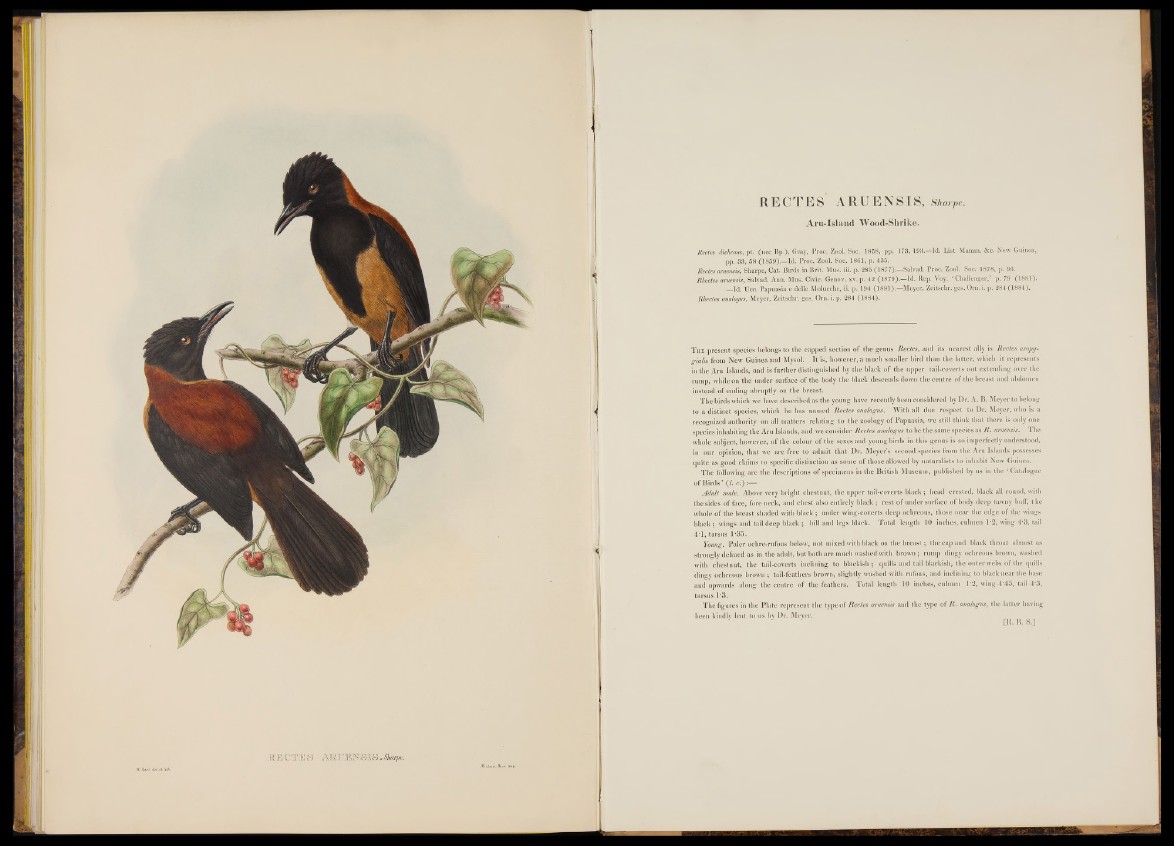
RECTES ARUENSIS, Sharpe.
Aru-Island Wood-Shrike,
Rectes dichrous, pt. (nee B p .), Gray, Proc. Zool. Soc. 1858, pp. 173, 193.—Id. List Mamm. &c. New Guinea,
pp. 33, 58 (1 8 5 9 ).—Id. Proc. Zoöl. Soc. 1861, p. 435.
Rectes aruensis, Sharpe, Cat. Birds in Brit. Mus. iii. p. 285 (18 7 7 ).—Salvad. Proc. Zool. Soc. 1878, p. 96.
Rhectes aruensis, Salvad. Ann. Mus. Civic. Genov, xv. p. 42 (1 8 7 9 ),—Id. Rep. Voy. ‘ Challenger,’ p. 79 (1881).
—Id. Ucc. Papuasia e delle Molucche,-ii. p. 194 (1 8 8 1 ).—Meyer, Zeitschr. ges. Orn. i. p. 284 (18 8 4 ).
Rhectes analogus, Meyer, Zeitschr. ges. Orn. i. p. 284 (1884).
T h e present species belongs to the capped section of the genus Rectes, and its nearest ally is Rectes uropy-
gialis from New Guinea and Mysol. It is, however, a much smaller bird than the latter, which it represents
in the Aru Islands, and is further distinguished by the black o f the upper tail-coverts not extending over the
rump, while on the under surface of the body the black descends down the centre of the breast and abdomen
instead of ending abruptly on the breast.
The birds which we have described as the young have recently been considered by Dr. A. B. Meyer to belong
to a distinct species, which he has named Rectes analogus. With all due respect to Dr. Meyer, who is a
recognized authority on all matters relating to the zoology o f Papuasia, we still think that there is only one
species inhabiting the Aru Islands, and we consider Rectes analogus to be the same species as R . aruensis. The
whole subject, however, o f the colour of the sexes and young birds in this genus is so imperfectly understood,
in our opinion, that we are free to admit that Dr. Meyer’s second species from the Aru Islands possesses
quite as good claims to specific distinction as some o f those allowed by naturalists to inhabit New Guinea.
The following are the descriptions o f specimens in the British Museum, published by us in the ‘ Catalogue
of Birds I (/. c.) :—
Adult male. Above very bright chestnut, the upper tail-coverts black ; bead crested,' black all round, with
the sides o f face, fore neck, and chest also entirely black ; rest o f under surface of body deep tawny buff, the
whole o f the breast shaded with black ; under wing-coverts deep ochreous, those near the edge o f the wings
black ; wings and tail deep black ; bill and legs black. Total length 10 inches, culmen T2, wing 4*3, tail
4 ‘1, tarsus 1*35.
Young. Paler ochre-rufous below, not mixed with black on the breast; the cap and black throat almost as
strongly defined as in the adult, but both are much washed with brown ; rump dingy ochreous brown, washed
with chestnut, the tail-coverts inclining to blackish; quills and tail blackish, the outer webs of the quills
dingy ochreous brown ; tail-feathers brown, slightly washed with rufous, and inclining to black near the base
and upwards along the centre o f the feathers. Total length 10 inches, culmen T2, wiug 4 -45, tail 4*3,
tarsus 1*3.
The figures in the Plate represent the type o f Rectes aruensis and the type of R . analogus, the latter having
been kindly lent to us by Dr. Meyer.
[R .B .S .]